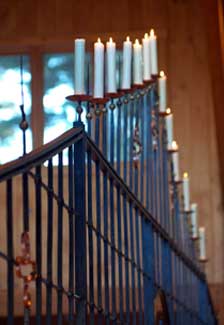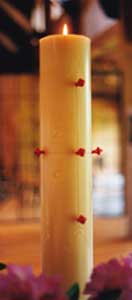
 |
|
|

Go directly to Triduum and Easter Liturgy Schedule. The liturgy of Holy Week is starkly beautiful, with rites and symbols that evoke and express the profound mysteries of Christ’s passion, death and resurrection. The community is given to its inexorable forward movement into and through the Passion. We are privileged to offer original translations of the hymns for Passiontide and Good Friday as well as the Easter vigil proclamation, the Exultet. Latin texts were translated by Abbey friend and classicist, Joseph T. Moller.  On Palm Sunday, the Mass begins with the Procession of the Palms through the church, signifying the entrance of Jesus into Jerusalem. During Mass, one of the Synoptic Gospel narratives of the Passion is sung in Latin by the Oblate Choir with soloists singing the parts of Christus and the Chronista (Narrator) and other choir members singing the part of the Synagoga (Crowd). (Translations are available.) At Mass on both Tuesday and Wednesday of Holy Week, the Passion account from the two remaining Synoptic Gospels, respectively, is read or re-enacted in English by members of the Community and persons in relationship. On Palm Sunday, the Mass begins with the Procession of the Palms through the church, signifying the entrance of Jesus into Jerusalem. During Mass, one of the Synoptic Gospel narratives of the Passion is sung in Latin by the Oblate Choir with soloists singing the parts of Christus and the Chronista (Narrator) and other choir members singing the part of the Synagoga (Crowd). (Translations are available.) At Mass on both Tuesday and Wednesday of Holy Week, the Passion account from the two remaining Synoptic Gospels, respectively, is read or re-enacted in English by members of the Community and persons in relationship. Tenebrae is the name given to the service of Matins and Lauds sung on each morning of the three days of the Sacred Triduum: Holy Thursday, Good Friday, and Holy Saturday. The Office of Tenebrae (literally “shadows”) is so called because by tradition it is sung in the darkness of the early morning hours. During Tenebrae, the heart-rending and haunting Lamentations of Jeremiah are sung by individual members of the monastic choir. When the service begins, all of the candles on the corona of the grille have been lighted. As each psalm is completed, a candle is extinguished until only one remains, signifying Christ, the source of light, amidst the gathering darkness of the Passion.
Tenebrae is the name given to the service of Matins and Lauds sung on each morning of the three days of the Sacred Triduum: Holy Thursday, Good Friday, and Holy Saturday. The Office of Tenebrae (literally “shadows”) is so called because by tradition it is sung in the darkness of the early morning hours. During Tenebrae, the heart-rending and haunting Lamentations of Jeremiah are sung by individual members of the monastic choir. When the service begins, all of the candles on the corona of the grille have been lighted. As each psalm is completed, a candle is extinguished until only one remains, signifying Christ, the source of light, amidst the gathering darkness of the Passion. On Holy Thursday, the Mass of the Lord’s Supper takes place in the evening. Within this Mass is the ceremony of the washing of the feet, also known as the Mandatum, a name taken from the words of Christ: Mandatum novum do vobis diligatis invicem, sicut dilexi vos! (“A new command I give you: love one another. As I have loved you, so you must love one another.”) In this ceremony, the celebrant washes the feet of twelve specially chosen apostles, demonstrating by this act the humility of Christ in giving himself without reserve to his disciples in this act of love. Following Mass, the Blessed Sacrament is carried through the church by the celebrant, then brought to the Altar of Repose. All remain in the church for the Stripping of the Altar, and finally the Office of Compline is sung in the darkened church, followed by Eucharistic Adoration.  On Good Friday afternoon, the Solemn Liturgy of the Passion takes place, which consists of three parts: The Liturgy of the Word, during which the Passion from the Gospel of Saint John is sung in Latin (translations available), and the Prayers for the Universal Church are offered; the Adoration of the Cross, an ancient ritual in which the cross is venerated while the prayers known as the Improperia, or “Reproaches”, are sung in Greek and Latin; and Holy Communion. On Good Friday afternoon, the Solemn Liturgy of the Passion takes place, which consists of three parts: The Liturgy of the Word, during which the Passion from the Gospel of Saint John is sung in Latin (translations available), and the Prayers for the Universal Church are offered; the Adoration of the Cross, an ancient ritual in which the cross is venerated while the prayers known as the Improperia, or “Reproaches”, are sung in Greek and Latin; and Holy Communion. The culmination of the Holy Week Liturgy begins with the Easter Vigil on Holy Saturday night. A large fire is lit outside the Church; the new fire is blessed by the priest, and this fire is used to light the Paschal candle. The congregation and community process together into the Church, following the Paschal candle.  Once all are inside the church, the candle of each one present is lighted and the Easter Proclamation, or Exultet, is sung, an ancient chant that summons all to rejoice in the Resurrection of Christ as embodied in the return of light through the Paschal candle. This concludes the first part of the Easter Vigil, the Liturgy of Light.
Read original English translation of the Exultet. Once all are inside the church, the candle of each one present is lighted and the Easter Proclamation, or Exultet, is sung, an ancient chant that summons all to rejoice in the Resurrection of Christ as embodied in the return of light through the Paschal candle. This concludes the first part of the Easter Vigil, the Liturgy of Light.
Read original English translation of the Exultet.The Liturgy of the Word follows, comprising seven Old Testament readings with responsories sung in Gregorian chant. Before the Epistle is read, the Gloria is once again proclaimed, and the bells ring out the news of the Resurrection. And finally, before the reading of the Gospel, the Alleluia, which has been “buried” or silent all through Lent, is joyfully proclaimed! The Liturgy of Baptism begins with the Litany of the Saints, followed by the Blessing of Water and the renewal of Baptismal vows. The members of the abbatial community renew their monastic vows at this time. The Liturgy of the Eucharist begins. On Easter Sunday morning, the Easter procession through the church is followed by Mass. At Mass there is again the opportunity for those present to renew their Baptismal vows. See photographs of life-size welded steel sheep inspired by the liturgy of HOLY WEEK. The sheep represent the movement of the Lamb of God through his Passion, Death and Resurrection. HOLY THURSDAY
GOOD FRIDAY
HOLY SATURDAY
EASTER SUNDAY
| |||||||||||||||||||||||||||||||||||||||||||||||||||||||||||||||||||
| Copyright © 2013 Abbey of Regina Laudis. All rights reserved. | ||||||||||||||||||||||||||||||||||||||||||||||||||||||||||||||||||||